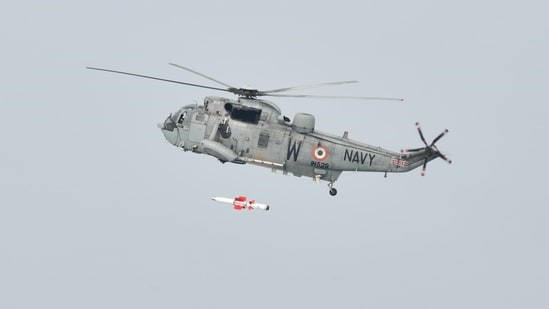Description

Disclaimer: Copyright infringement not intended.
Context
- The recent development regarding the successful trial of India's indigenous Naval Anti-Ship Missile Short Range (NASM-SR) holds significant importance in the country's defense capabilities.
Details
Significance
- Indigenous Missile Advancements: The NASM-SR test signifies India's progress in developing indigenous naval armaments, boosting self-reliance in defense technology, and reducing dependency on imports.
- Collaboration between DRDO and Indian Navy: The successful trial represents a collaborative effort between the Defence Research and Development Organisation (DRDO) and the Indian Navy, showcasing joint endeavors in enhancing naval firepower.
- Technological Advancements: The NASM-SR incorporates advanced technologies, featuring an indigenous launcher for helicopters and a guidance system with state-of-the-art navigation and integrated avionics, reflecting India's technological capabilities in missile development.
Development in Long-Range Missiles
- Long Range Anti-Ship Missile: India's preparations for the inaugural trial of a new Long Range Anti-Ship Missile, surpassing the range of the BrahMos missile, demonstrate the country's endeavor to develop missiles with extended operational ranges, enhancing maritime defense capabilities.
- Enhanced Range of BrahMos: The BrahMos missile, developed jointly by India and Russia, has undergone advancements, with an extended range from its original 290 km to a range of 350 to 400 km, further bolstering India's missile capabilities.
Complementary Defense Capabilities
- MRSAM's Effectiveness: The successful firing of the Medium Range Surface-to-Air Missile (MRSAM) from INS Visakhapatnam in March demonstrates India's capability to intercept Anti-Ship Missiles, showcasing a multi-layered defense approach.
- Collaboration with International Entities: Collaborative efforts between DRDO and Israeli Aerospace Industries (IAI) for the development of MRSAM highlight India's engagements with global defense entities to strengthen its defense systems.

About
- Anti-ship missiles (ASMs) are advanced guided projectiles specifically designed to target and destroy surface ships, making them a critical component of naval warfare.
- These missiles are engineered to be launched from various platforms such as aircraft, ships, submarines, and coastal defense batteries.
Key Features of Anti-Ship Missiles:
- Guidance Systems: ASMs employ advanced guidance systems such as radar, infrared, GPS, and inertial navigation systems to locate and home in on their targets accurately.
- Versatile Platforms: They can be deployed from different launch platforms, including aircraft (air-launched), ships (surface-launched), submarines (submarine-launched), and coastal defense systems (land-based launchers).
- Stealth and Maneuverability: Modern ASMs are designed to be stealthy and possess high maneuverability to evade enemy defenses, including anti-missile systems and countermeasures.
- Warhead Options: These missiles are equipped with various warhead types, including high-explosive, armor-piercing, shaped charges, and sometimes even nuclear warheads, maximizing their impact on targets.
Types of Anti-Ship Missiles:
- Subsonic Missiles: These travel at speeds below the speed of sound and are often used for shorter-range engagements, typically utilizing cruise missile technology.
- Supersonic Missiles: Known for their high speeds surpassing the speed of sound, these missiles have enhanced striking capabilities, providing limited reaction time for adversaries.
- Hypersonic Missiles: The latest advancements in missile technology have led to the development of hypersonic ASMs, capable of achieving speeds more than five times that of sound, making them extremely difficult to intercept.
Notable Anti-Ship Missile Systems:
- Harpoon: A widely used anti-ship missile system by various navies globally, known for its effectiveness and operational history.
- BrahMos: Jointly developed by India and Russia, this supersonic cruise missile is one of the fastest anti-ship missiles in service, known for its accuracy and range.
- Exocet: A French-built missile system deployed by numerous navies worldwide, recognized for its potency and successful track record in conflicts.
- YJ-18: A Chinese anti-ship missile system with unique capabilities, including subsonic and supersonic flight modes, making it difficult to counter.
Strategic Importance and Military Applications:
- Naval Warfare: ASMs play a crucial role in naval warfare, acting as a deterrent and a primary offensive weapon against enemy ships, disrupting maritime operations.
- Strategic Defense: They provide a layer of defense against hostile naval forces, securing territorial waters and strategic maritime regions.
- Force Projection: The possession of advanced anti-ship missiles enhances a nation's ability to project power and influence in maritime regions, shaping geopolitical strategies.
Evolving Threats and Countermeasures:
- Counter-ASMs: Nations continuously develop and deploy counter-ASM systems, including anti-missile defense, electronic warfare, and decoy systems, to neutralize incoming ASMs.
- Technological Advancements: Ongoing research focuses on improving missile accuracy, range, speed, stealth, and maneuverability to stay ahead of evolving threats and defenses.

Conclusion
India's advancements in indigenous missile technology, particularly in developing naval anti-ship missiles like NASM-SR and Long Range Anti-Ship Missiles, alongside the successful trials of MRSAM, showcase the country's commitment to bolstering its defense capabilities. These developments signify strides towards self-reliance in defense, technological advancements, and reinforcing India's position in the realm of maritime security and defense.
|
PRACTICE QUESTION
Q. Discuss the strategic significance of anti-ship missiles in modern naval warfare, highlighting their technological advancements, operational versatility, and evolving role in shaping maritime strategies. Evaluate the challenges posed by anti-ship missiles and the measures taken by nations to counter these threats. (250 Words)
|













